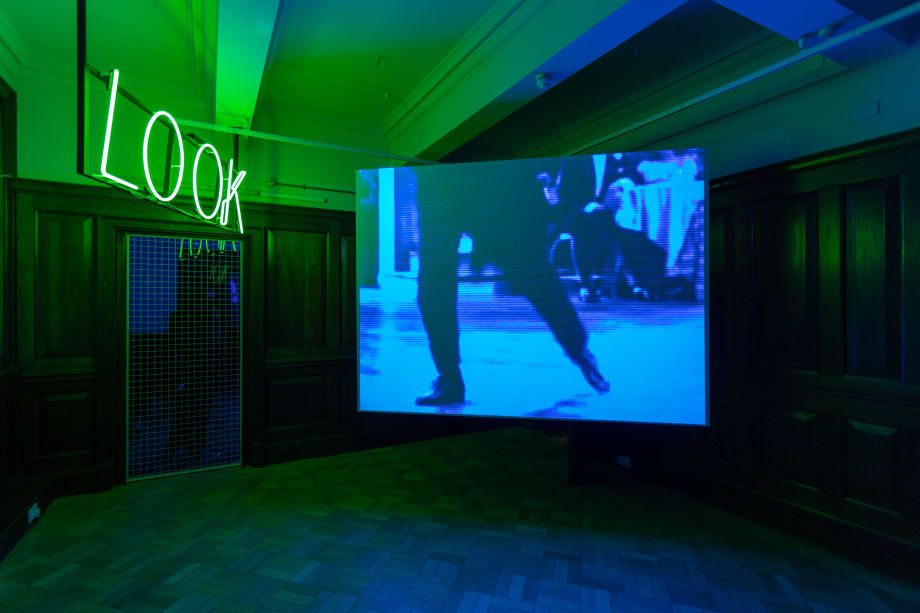In late 1980s Britain, the UK club scene was born. Out of the hostile political climate, strategies of cultural resistance emerged through dance music which brought together the politics of activism with the subtle eroticism of disco in a ‘celebration of dancefloor sexuality’ and collectivity.[1]
This is the backdrop to Simeon Barclay’s Bus2move, a body of work informed by Barclay’s research residency at the Phoenix Dance Theatre in Leeds, which was set up in 1981 by three friends as an all-men, all-black dance company who performed to reggae and dance music. A series of propositions and thresholds comprise the exhibition, beginning with the title itself, which Barclay describes as, ‘a pronouncement of what you’re going to do on the dancefloor.’ This performative potential runs through the exhibition, where the viewer is invited and denied, by turns, into a series of hypnotic and sometimes disorientating nocturnal environments that reconfigure and resist The Tetley’s architecture.
The exhibition begins in the daylight of the Tetley’s lofty Atrium. The space feels like an empty stage awaiting activation, or the residue of something that has already happened. Barclay’s blown-glass sculptural tautology, ‘Slight’ (2018) sits high up on the wall, barely visible if you are not looking for it. On the floor, the configuration and scale of transparent orange acrylic cube sculptures that make Barclay’s ‘Fail to Learn’ (2018) subtly reference the box-shaped props used by dancers in the accompanying video documentation of ‘Calyx’ (2017), a performance inspired by Baudelaire’s erotic collection of poems Flowers of Evil (1857), selected by Barclay from the Phoenix Dance Theatre’s archive. Like ‘Slight’, the sculptures in ‘Fail to Learn’ appear to borrow from the visual language of minimalism and the Light and Space movement. In an act of détournement, however, they in fact unexpectedly reveal various obscured copies of an image of the 1980s pop artist and self-proclaimed genius formerly known as Terence Trent D’Arby.
The appearance of specific figures or moments in popular culture that have personal resonance for Barclay are a familiar trope that runs throughout his work and reflect his ongoing interest in how we construct and perform our identities. His biography emerges through media images and his choice of materials in an accumulation of personal references. In the lightbox, ‘Truly, Madly, Deeply #1’ (2017), viewed from one perspective through wire mesh, a drawing of 1980s Vogue cover model Isabella Rossellini is just visible through the forensic blue light, next to a grainy tabloid-style photo of two footballers mid-tackle. Across the room, the rhythmic strobing orange beacon of ‘Learn to Fail’ (2018) momentarily reveals an almost life-size black and white photo from the 1980s of young boys in front of a drab-looking housing estate, speaking to popular perceptions and stereotypes of social class in Britain during Barclay’s childhood. In the dim blue glow and strobing light, the images in ‘Truly, Madly, Deeply #1’ and ‘Learn to Fail’ are difficult to perceive – a reminder of how the proliferation of images makes it both harder to see and easier to categorise faced with thousands of similar images seen before.
Questions around the legitimacy and agency of images and the ‘hierarchy’ within visual culture are addressed in ‘2 Step’ (2018), a red powder-coated steel and green acrylic screen blocking the entrance to one gallery. Barclay has rendered an abstract detail from Henri Matisse’s ‘The Dance (II)’ (1910) in the materials of mass-manufacturing – an industry that Barclay spent sixteen years working in – and re-named it after a hip hop dance move.
Elsewhere, dance continues to appear in visual, sonic and semantic forms throughout the exhibition. In ‘Look No Hands’ (2018), found video footage of two men participating in a dance-off to a pulsating soundtrack reveals fancy footwork only from the waist down. A green neon sign to the left of the screen demands the viewer to “LOOK” but not partake in the performance. The large screen bifurcates the small room, so that the video and neon can only be viewed together from one corner on the side lines – a reminder that this is not your dance floor.
In Bus2move, bodies are in motion, on display, together, performing a set of social relations that are erotic, competitive and disobedient. Barclay’s exhibition suggests that, while the social and political status quo continues to be reflected in a set of norms constructed through popular culture and the press, there are many ways to exercise our own subjectivity and autonomy as a strategy of resistance – one of which is through the emancipatory power of dance.
Simeon Barclay: Bus2move, The Tetley, Leeds, 27 October 2018 – 3 February 2019.
Laura Clarke is a curator based in Sheffield.
[1] David Hesmondhalgh, The Cultural Politics of Dance Music, Soundings Magazine, issue 5, spring 1997

